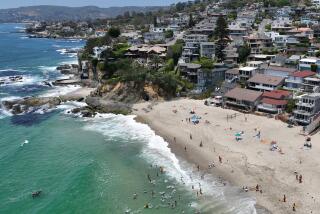Latest Hawaii Sport Faces a Back-Splash
- Share via
KAILUA, Hawaii — “He went up in the air and did this 360 and just kept right on going. It was phenomenal!” That’s how beachgoer Lori Harrison reacted to Hawaii’s hottest thrill sport: kite surfing.
Some others who live near this gentle Oahu bay, however, are less than enchanted.
Kite surfers use a board with foot straps and a large, crescent-shaped kite to catch the wind and propel them across the water--and into the air.
It may be breathtaking, but it can take up a lot of room. Before launching, kite surfers stretch their 100-foot-long lines along the beach. Once aloft, at least in the hands of beginners, kites have been known to land in unexpected places.
So when kite boarders, as they also are called, began showing up in force last fall at Kailua--a white sand beach framed by volcanic islets just 15 miles from Honolulu--the complaints began.
Kite surfers were accused of hogging the beach--already a favorite with sunbathers, swimmers, windsurfers and kayakers. Some onlookers feared that wayward kites would envelop swimmers and that the lines could entangle passersby. Beachfront homeowners groused about trespassers retrieving the inevitable kite-in-a-tree, breaking tree limbs in the process.
“There used to be one or two kite surfers,” said Carol Paris, president of the Puukani Place Homeowners Assn. “Now you get 20 or 30 in action. Kites have landed on people in the water. . . . Some people have received rope burns.”
Added Duane Samson, chairman of the parks and recreation committee of the Kailua Neighborhood Board: “We really don’t want to see this become a kite surfing park.”
Kite surfing’s lure of “flying” has made converts of many windsurfers--including Kailua resident Robbie Naish, a world champion in both sports who happened to give Harrison a free show.
A gentle wind of 10 mph or so can lift a grown man 10 feet above the ocean. Stronger winds will take you farther.
“With windsurfing, the momentum of the sail and board can drive you up into the air, but you go up and you come down--and you come down kind of hard,” said Donnel Nunes, president of the Oahu chapter of the Hawaii Kiteboarding Assn. “With the kite, you go up and you stay up. You may be in the air for five or six seconds, flying 100 feet across the water, and it’s pretty spectacular.”
In recent months, the Kailua Neighborhood Board has held some spirited meetings and talked of trying to ban the sport--just as personal watercraft were banished some years ago. In December, the board passed a unanimous resolution calling on the state to regulate kite surfing.
In hopes of staving off a ban, kite surfers formed an association and instituted voluntary rules to minimize their effect on the beach.
They have set aside a launching area, away from people’s homes, where the kite surfers queue up one at a time. There also is supposed to be someone assisting boarders during the launch and landing. Once in the water, they are advised to remain 200 feet from the beach.
“It’s not the experienced guys that are the problem, it’s the guys who don’t know what they’re doing,” said Nunes, who is working to educate the renegades. “I tell people we’re always one kiter away from being shut down. We have to hold ourselves to a higher standard than the city or state would ever expect of us.”
Their efforts have impressed some critics, including Paris. And while neighbor Joe Gilman grumbles that kite surfers have knocked down his weather vane several times, he acknowledges that things are improving. “They’re working hard at it. They’ve got to, because they don’t want to get banned.”
Initially just a Kailua group, the Hawaii Kiteboarding Assn. quickly went islandwide, then statewide. “I’ve had contact with people from Germany, Argentina, Australia--all inquiring about what we’re doing,” Nunes said.
The sport, which is said to have begun along the coast of Senegal nearly a decade ago, has spread through Europe and the United States in recent years.
Along with the thrill of flying through the air, it has several advantages over windsurfing. For one, it’s easier to master. It also requires less equipment--no masts or booms. Kites vary in size but average about 7 feet by 20 feet, with inflatable battens, or ribs. The kite folds neatly into a backpack and weighs less than 2 pounds. Boards range from 5 to 7 feet long.
Kite boarding also requires less wind. So even on flat water, as long as there is a breeze, “you can jump as high as you want,” said Katie Naish, Robbie’s wife and an avid kite surfer herself.
“Every single person I know, the minute they tried it, they’re hooked,” she said.
While kite surfers run the risk of ankle and knee injuries, they contend that onlookers have little to fear.
“The kite weighs nothing,” said Peter Michelmore, owner of Gravity Sports in Kailua. “If you really get hit by one, it’s not a big deal. It’s just scary.”
More to Read
Sign up for The Wild
We’ll help you find the best places to hike, bike and run, as well as the perfect silent spots for meditation and yoga.
You may occasionally receive promotional content from the Los Angeles Times.






